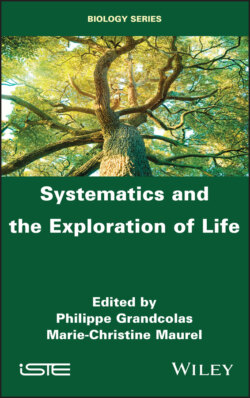Systematics and the Exploration of Life

Реклама. ООО «ЛитРес», ИНН: 7719571260.
Оглавление
Группа авторов. Systematics and the Exploration of Life
Table of Contents
List of Tables
List of Illustrations
Guide
Pages
Systematics and the Exploration of Life
Introduction. Exploring Biodiversity: Science Must Seize the Unknown 80%
References
1. Symmetry of Shapes in Biology: from D’Arcy Thompson to Morphometrics. 1.1. Introduction
1.2. D’Arcy Thompson, symmetry and morphometrics
1.3. Isometries and symmetry groups
1.4. Biological asymmetries
1.5. Principles of geometric morphometrics
1.6. The treatment of symmetry in morphometrics
1.7. Some examples of applications
1.8. Conclusion
1.9. References
2. Impact of a Point Mutation in a Protein Structure. 2.1. Composition
2.2. Folding
2.3. Substitution(s) in protein structures
2.4. Effect on overall structure and function
2.5. Effect on stability
2.6. Effect on the peptide backbone
2.7. Conclusion
2.8. References
3. The Role of Taxonomy and Natural History in the Study of the Evolution of Eneopterinae Crickets
3.1. Introduction
3.2. Taxonomy in modern comparative approaches
3.3. A model group
3.4. Contribution of taxonomy for phylogenetic reconstructions and classification. 3.4.1. Monophyly
3.4.2. Recent taxonomic contributions
3.4.3. Phylogeny and taxonomy
3.5. Contribution of taxonomy to biogeography
3.5.1. New Caledonia
3.5.2. Southeast Asia
3.6. Taxonomic exploration and evolution of species traits
3.7. Conclusion
3.8. Acknowledgments
3.9. References
4. Systematics in the (Post)genomic Era: A Look at the Drosophila Model
4.1. Drosophila: a star of genetics but a systematic nebula
4.2. Subspecies: identification of “genomic islands of divergence”?
4.3. Species complexes: congruence between species trees and gene trees
4.4. Supraspecific ranks: phylogeny, genome and morphome
4.5. Conclusion
4.6. Acknowledgments
4.7. References
5. Dealing with Multiple Environments: The Challenges of the Trypanosome Lifecycle. 5.1. Human African trypanosomiasis, the disease
5.2. Cell biology of Trypanosoma brucei
5.3. Survival and maturation of T. brucei in the tsetse vector
5.4. Adaptations of T. brucei to the mammalian host
5.5. Conclusion
5.6. References
6. Challenges Inherent in the Systematics and Taxonomy of Genera that have Recently Experienced Explosive Radiation: The Case of Orchids of the Genus Ophrys
6.1. Introduction
6.2. Speciation in Ophrys: an evolutionary divergence seen as a reticulated continuum. 6.2.1. Difficulty in applying the biological concept of the species in the case of Ophrys
6.2.2. Causes of reproductive isolation in Ophrys
6.2.3. Consequences of the implementation of reproductive isolation in the particular case of the genus Ophrys
6.3. Current state of knowledge on Ophrys systematics. 6.3.1. Molecular systematics: overview of current knowledge
6.3.2. Molecular systematics in the age of phylogenomics
6.4. Integrative genomics and taxonomy: perspectives and issues. 6.4.1. Moving towards a generalization of data sets at the genomic scale
6.4.2. Integrative taxonomy approach
6.5. Conclusion
6.6. Acknowledgments
6.7. References
7. Exploration and Origins of Biodiversity in Madagascar: The Message of Ferns. 7.1. Introduction
7.2. Madagascar: a complex biogeographical context. 7.2.1. An insular continental territory that is not so isolated
7.2.2. Gradients, ecosystem diversity and biodiversity
7.3. Ferns and lycophytes: an ideal model for the biogeography of Madagascar
7.4. Origins of the lineages of ferns in Madagascar. 7.4.1. Multiple long-distance dispersions
7.4.2. The Neotropics: a non-exclusive but preponderant role
7.4.3. Africa: a truly minimal role or an underestimated role?
7.5. The example of Rumohra: dispersions to Madagascar and around the world
7.6. Conclusion
7.7. References
8. Mediterranean and Atlantic Algae, a Fraternal Relationship?
8.1. Introduction. 8.1.1. Seaweeds
8.1.2. The systematics of algae
8.1.3. Algae distribution on a global scale
8.1.4. Seaweeds on the Atlantic and Mediterranean coasts
8.1.5. Challenge of the study
8.2. Materials and methods. 8.2.1. Sampling strategy
8.2.2. Acquisition of molecular data
8.2.3. Analysis of phylogenetic relationships between Atlantic and Mediterranean specimens
8.3. Results
8.4. Discussion
8.5. Acknowledgments
8.6. References
9. Ontogeny and Evolution of the Hyperorgan of Delphinieae
9.1. Introduction
9.2. Synorganization: a concept, definitions. 9.2.1. Adolf Remane and the synorganization of animal structures
9.2.2. A concept adopted by botanists, and by flower specialists in particular
9.2.3. A concept to be limited organically, and to be placed in a phylogenetic framework
9.3. Ontogeny and evolution of the hyperorgan of Delphinieae. 9.3.1. Disparity of the hyperorgan in the tribe
9.3.2. Ontogeny of the synorganized structure
9.3.3. Evolving trends and convergences
9.4. The study of synorganization in evolutionary biology. 9.4.1. Lessons learned from the synorganization study
9.4.2. Scientometrics to measure the impact of the concept of synorganization in evolutionary biology
9.4.3. Synchronization, integration, co-adaptation, redundant concepts?
9.5. Conclusion
9.6. Acknowledgments
9.7. References
10. Identification of Interspecific Chromosomal Homologies: Chromosomal Microdissection and Chromosomal Painting in Antarctic Teleosts Nototheniidae. 10.1. Introduction. 10.1.1. Homologies, painting and chromosomal microdissection
10.1.2. ICH research in Nototheniidae
10.2. Materials and methods. 10.2.1. Materials
10.2.2. Methods. 10.2.2.1. Microdissection and elaboration of the painting probe. 10.2.2.1.1. Chromosome preparations
10.2.2.1.2. Constitution of batches of microdissected homologous chromosomes
10.2.2.1.3. Amplification, purification and quantification of products
10.2.2.2. Development of competitor DNA
10.2.2.3. Painting. 10.2.2.3.1. Probe labeling
10.2.2.3.2. FISH
10.2.2.3.3. Observation, capture and processing of images
10.3. Results. 10.3.1. Microdissection
10.3.2. Painting. 10.3.2.1. Hybridizations of the chromosome-specific painting probe on chromosomes of the same specimen, T. pennellii (EC 4313) (positive control)
10.3.2.2. Hybridations of the chromosome-specific painting probe on chromosomes of other species of Nototheniidae: T. hansoni, N. coriiceps and D. mawsoni
10.4. Discussion. 10.4.1. Technical aspects developed and prospects for improvement of the painting signal
10.4.2. The largest pair of chromosomes of T. pennellii, the product of two chromosomal fusions (roberstonian and tandem)
10.5. Conclusion
10.6. References
List of Authors
Index
A, B, C
D, E, F
G, H, I
J, L, M
N, P, R
S, T, U, V
WILEY END USER LICENSE AGREEMENT
Отрывок из книги
Series Editor
.....
Wilson, E.O. (ed.) (1988). Biodiversity. National Academies Press, Washington.
Introduction written by Philippe GRANDCOLAS and Marie-Christine MAUREL.
.....